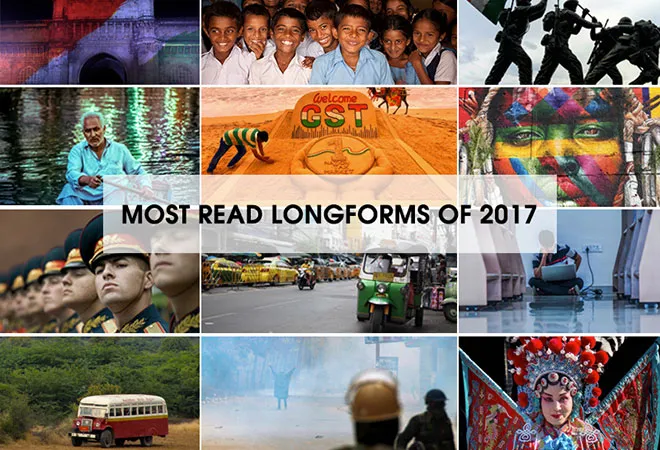
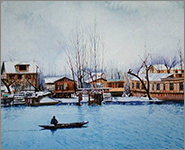 Reimagining Kashmir | Barkha Dutt
Reimagining Kashmir | Barkha Dutt
Sometimes a single image can capture the essence of a complex issue in a way that a million words cannot. To cut through the din of high-decibel, shrill rhetoric from primetime ‘patriots’ pontificating on Jammu and Kashmir, look no further than the searing art of Masood Hussain.
Read more >
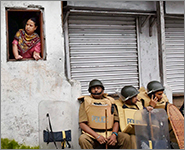 Fire in the hills: As Darjeeling burns, bad news for India | Kanchan Gupta
Fire in the hills: As Darjeeling burns, bad news for India | Kanchan Gupta
Long dormant, the desire for a Gorkhaland has been given new breath by the West Bengal government's ill-conceived move to impose the teaching of Bengali to Nepali-speaking Gorkhas. Language supremacism and intrusive politics have coalesced to trigger a popular backlash, and the hills of Darjeeling and Kalimpong districts, straddling strategic topography, are in ferment. What are the implications of this simmering conflict on Calcutta and New Delhi; what are their options?
Read more >
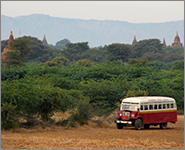 The road to Mekong: The India-Myanmar-Thailand trilateral highway project | Naresh Bana & K. Yhome
The road to Mekong: The India-Myanmar-Thailand trilateral highway project | Naresh Bana & K. Yhome
As India places the Mekong sub-region among its priorities under the country’s ‘Act East’ policy, the ongoing India-Myanmar-Thailand Trilateral Highway project — currently the only land connectivity project between India and the Mekong countries and the wider Southeast Asian region — could prove to be a game changer.
Read more>
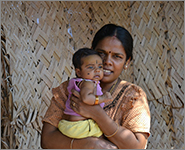 Preventing hunger and malnutrition in India | Rumi Aijaz
Preventing hunger and malnutrition in India | Rumi Aijaz
The prevalence of malnutrition — encompassing both undernutrition and overnutrition — is an important indicator of a country’s health. Those who are either undernourished or are obese underperform in various aspects of life, missing out on opportunities to become productive members of society.
Read more>
 The enduring relevance of India-Russia relations | Nandan Unnikrishnan
The enduring relevance of India-Russia relations | Nandan Unnikrishnan
The impact of Indo-Russian relations on the domestic and foreign policies of India from the 1960s is difficult to underestimate. The USSR was instrumental in helping independent India industrialise, develop its scientific potential, and defend its territorial integrity. Today the two countries need to find new ways to reignite their ties in a rapidly changing international system.
Read more>
 Implementation issues in India’s GST | Aparajit Pandey
Implementation issues in India’s GST | Aparajit Pandey
While the new system has been acknowledged as beneficial in a number of ways, there remain concerns regarding its implementation. If handled poorly, this tax reform could have long-term effects on the Indian economy.
Read more>
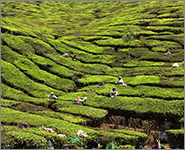 Economic reforms 2.0: Recommendations for a new economic agenda for India | Nilanjan Ghosh & Parthapratim Pal
Economic reforms 2.0: Recommendations for a new economic agenda for India | Nilanjan Ghosh & Parthapratim Pal
The last 25 years since India began embarking on economic reforms provide various lessons for current economic policy-makers as they look ahead to future challenges that face the country and seek to combat such difficulties. This report provides broad recommendations for setting the agenda for India’s ‘economic reforms 2.0’.
Read more>
 The great Indian exam debacle | Prashant Bhattacharji & Geeta Kingdon
The great Indian exam debacle | Prashant Bhattacharji & Geeta Kingdon
The “marks moderation” debate, which made headlines this summer, resulted in a frenzied, but incomplete, media coverage. There has been litigation as well, stalling the declaration of high-school results of students of the Central Board of Secondary Education (CBSE), Council for the Indian School Certificate Examinations (CISCE), and various state boards. The boards are competing to stay relevant by awarding increasingly high scores, thus diluting academic standards and pulling down the public’s trust in the assessment system.
Read more>
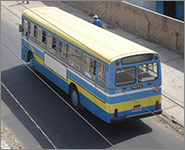 Indian investments in Africa: Scale, trends, and policy recommendations | Malancha Chakrabarty
Indian investments in Africa: Scale, trends, and policy recommendations | Malancha Chakrabarty
Indian investments in Africa, from both public and private sector entities, have increased considerably in the last decade. Yet despite the growing importance of Indian investments in Africa, only a few empirical studies have been carried out on the subject.
Read more>
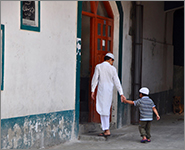 Countering violent extremism: Lessons for India | Maya Mirchandani
Countering violent extremism: Lessons for India | Maya Mirchandani
How serious a challenge is online radicalisation for India’s security establishment, whether through subterranean and dangerously violent sites on the “dark net” or simply the wide availability of extremist content on social networking platforms such as YouTube, Facebook, WhatsApp and Twitter? Is there now a need to go beyond purely strategic, law enforcement-based approaches in tackling the very real threat of terror and violence?
Read more>
 Surgical strikes and deterrence-stability in South Asia | Arka Biswas
Surgical strikes and deterrence-stability in South Asia | Arka Biswas
This paper analyses India’s surgical strikes of September 2016, their nature and the objectives with which they were conducted. Given that they meet most of India’s objectives and that their controlled nature renders possibilities of conflict escalation negligible, the paper concludes that surgical strikes strengthen deterrence-stability in South Asia and that they could become New Delhi’s modus operandi in responding to Pakistan’s sub-conventional war.
Read more>
 The four faces of 21st century Asian geopolitics | Abhijnan Rej
The four faces of 21st century Asian geopolitics | Abhijnan Rej
As global geopolitics enters a multipolar era, there is a need to assess the extent to which strategic concepts from the bipolar era remain valid and useful. In this brief, the notion of a ‘strategic triangle’, which became prominent during the Cold War, is extended to a ‘great-powers tetrahedron’ for Asia in the 21st century.
Read more>
 Countering insurgency in Kashmir: The cyber dimension | Vinay Kaura
Countering insurgency in Kashmir: The cyber dimension | Vinay Kaura
Countering the militancy in Kashmir has become a highly challenging task due to the exploitation of new information and communication technology by insurgent groups. The battlefield is now a multidimensional one, encompassing both physical territory and cyberspace.
Read more>
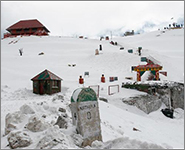 Doklam: To start at the very beginning | Manoj Joshi
Doklam: To start at the very beginning | Manoj Joshi
There is a geographical and geopolitical aspect to the ongoing Sino-Indian standoff in the Doklam region. Geography locates Bhutan on a sensitive part of the Himalayan belt. Its history, small size and state capacity have made it an element in the geopolitical contest between India and China.
Read more>
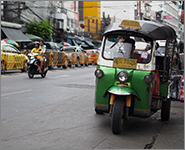 India-ASEAN partnership at 25 | Harsh V. Pant & Avantika Deb
India-ASEAN partnership at 25 | Harsh V. Pant & Avantika Deb
India-ASEAN relations have traversed a long, dynamic path interspersed with multiple achievements to reach the year 2017, when the two are celebrating 25 years of their partnership. India and ASEAN uphold each other’s centrality in shaping the evolving regional architecture.
Read more>
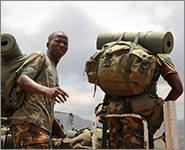 Somalia: A failed state? | Harish Venugopalan
Somalia: A failed state? | Harish Venugopalan
It will not be an exaggeration to say that almost all the countries in Africa face some form of conflict. Yet, most of them have managed to survive, and some—like South Sudan and the Democratic Republic of Congo—have even evolved into reasonably successful states. However, Somalia has not. What are the reasons for Somalia’s failure to survive?
Read more>
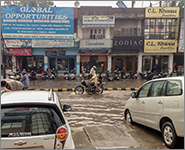 War on drugs: Challenges for the Punjab government | R.K. Arora & Vinay Kaura
War on drugs: Challenges for the Punjab government | R.K. Arora & Vinay Kaura
Most analysts agree that a dangerous mix of demand, supply and currency is responsible for Punjab’s drug menace. Punjab is both a transit point and a market for the drugs smuggled from the so-called Golden Crescent that is Pakistan, Afghanistan and Iran. While the heroin produced in Afghanistan is smuggled through the 553-km-long, porous India-Pakistan border, the opium, poppy husk, charas and hashish, among other drugs, come from the neighbouring states.
Read more>
 India’s response to state fragility in Africa | Urvashi Aneja
India’s response to state fragility in Africa | Urvashi Aneja
New Delhi is increasingly positioning itself as a significant player in African peace, security and development. Examining the question of how India responds to state fragility in Africa, this brief finds that India’s engagement is mostly transactional: working around, rather than on, sources of political fragility.
Read here>
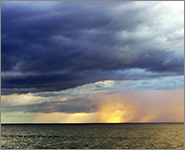 Blue economy: Beyond an economic proposition | Sonali Mittra
Blue economy: Beyond an economic proposition | Sonali Mittra
Blue economy is the integration of ocean economy development with values of social inclusion and environmental sustainability, along with dynamic and innovative business models. For India, however, blue economy extends beyond being merely an economic and environmental proposition. It presents India with an unprecedented opportunity to meet its national objectives, strengthen connectivity with neighbours, and exert influence in the surrounding regions.
Read more>
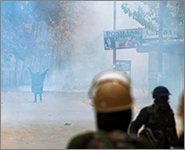 Dealing with violent civil protests in India | Kriti M. Shah
Dealing with violent civil protests in India | Kriti M. Shah
The citizens’ right to protest is a pillar of Indian democracy. While citizens are allowed to peacefully assemble, however, protests and demonstrations sometimes take a violent turn; recent examples are the Jat protests in Haryana and the Kashmir unrest following the death of militant leader Burhan Wani, both in 2016. During such occasions, it is the prerogative of the Indian state to deal with the violent civil protests in a manner that ensures public order and protects citizens from harm.
Read more>
The views expressed above belong to the author(s). ORF research and analyses now available on Telegram! Click here to access our curated content — blogs, longforms and interviews.




 Reimagining Kashmir | Barkha Dutt
Reimagining Kashmir | Barkha Dutt Fire in the hills: As Darjeeling burns, bad news for India | Kanchan Gupta
Fire in the hills: As Darjeeling burns, bad news for India | Kanchan Gupta The road to Mekong: The India-Myanmar-Thailand trilateral highway project | Naresh Bana & K. Yhome
The road to Mekong: The India-Myanmar-Thailand trilateral highway project | Naresh Bana & K. Yhome Preventing hunger and malnutrition in India | Rumi Aijaz
Preventing hunger and malnutrition in India | Rumi Aijaz The enduring relevance of India-Russia relations | Nandan Unnikrishnan
The enduring relevance of India-Russia relations | Nandan Unnikrishnan Implementation issues in India’s GST | Aparajit Pandey
Implementation issues in India’s GST | Aparajit Pandey Economic reforms 2.0: Recommendations for a new economic agenda for India | Nilanjan Ghosh & Parthapratim Pal
Economic reforms 2.0: Recommendations for a new economic agenda for India | Nilanjan Ghosh & Parthapratim Pal The great Indian exam debacle | Prashant Bhattacharji & Geeta Kingdon
The great Indian exam debacle | Prashant Bhattacharji & Geeta Kingdon Indian investments in Africa: Scale, trends, and policy recommendations | Malancha Chakrabarty
Indian investments in Africa: Scale, trends, and policy recommendations | Malancha Chakrabarty Countering violent extremism: Lessons for India | Maya Mirchandani
Countering violent extremism: Lessons for India | Maya Mirchandani Surgical strikes and deterrence-stability in South Asia | Arka Biswas
Surgical strikes and deterrence-stability in South Asia | Arka Biswas The four faces of 21st century Asian geopolitics | Abhijnan Rej
The four faces of 21st century Asian geopolitics | Abhijnan Rej Countering insurgency in Kashmir: The cyber dimension | Vinay Kaura
Countering insurgency in Kashmir: The cyber dimension | Vinay Kaura Doklam: To start at the very beginning | Manoj Joshi
Doklam: To start at the very beginning | Manoj Joshi India-ASEAN partnership at 25 | Harsh V. Pant & Avantika Deb
India-ASEAN partnership at 25 | Harsh V. Pant & Avantika Deb Somalia: A failed state? | Harish Venugopalan
Somalia: A failed state? | Harish Venugopalan War on drugs: Challenges for the Punjab government | R.K. Arora & Vinay Kaura
War on drugs: Challenges for the Punjab government | R.K. Arora & Vinay Kaura India’s response to state fragility in Africa | Urvashi Aneja
India’s response to state fragility in Africa | Urvashi Aneja Blue economy: Beyond an economic proposition | Sonali Mittra
Blue economy: Beyond an economic proposition | Sonali Mittra Dealing with violent civil protests in India | Kriti M. Shah
Dealing with violent civil protests in India | Kriti M. Shah PREV
PREV

